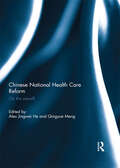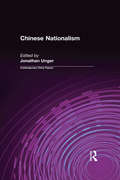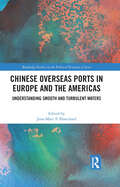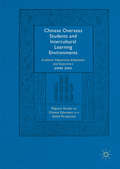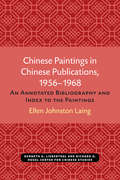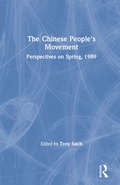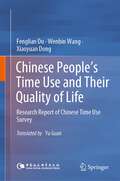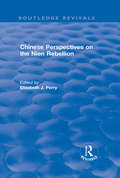- Table View
- List View
Chinese National Health Care Reform: On the Mend?
by Alex Jingwei He and Qingyue MengFive years have elapsed since the Chinese government announced its ambitious health care reform programme. The fact that both the United States and China unfolded their gigantic national health care reforms almost simultaneously is reflective of the daunting health policy challenges that most national governments are grappling with. While Obamacare has barely survived the obstruction from Congress and remains controversial, its Chinese counterpart has concluded its first phase at a fairly smooth pace. Having had three trillion RMB invested into it within five years, this landmark reform stands out as one of the biggest health policy interventions in modern history in terms of both scale and scope. A critical juncture in the reform process has been reached and it is time to assess its performance to date. This book provides an interim evaluation of China’s ongoing national health care reform from interdisciplinary perspective. Insights generated are not only valuable to inform next phase of the reform, but also relevant to health policy reformers in other developing and transitional countries.This book was published as a special issue of the Journal of Asian Public Policy.
Chinese National Health Care Reform: On the Mend?
by Alex Jingwei He Qingyue MengFive years have elapsed since the Chinese government announced its ambitious health care reform programme. The fact that both the United States and China unfolded their gigantic national health care reforms almost simultaneously is reflective of the daunting health policy challenges that most national governments are grappling with. While Obamacare has barely survived the obstruction from Congress and remains controversial, its Chinese counterpart has concluded its first phase at a fairly smooth pace. Having had three trillion RMB invested into it within five years, this landmark reform stands out as one of the biggest health policy interventions in modern history in terms of both scale and scope. A critical juncture in the reform process has been reached and it is time to assess its performance to date. This book provides an interim evaluation of China’s ongoing national health care reform from interdisciplinary perspective. Insights generated are not only valuable to inform next phase of the reform, but also relevant to health policy reformers in other developing and transitional countries.This book was published as a special issue of the Journal of Asian Public Policy.
Chinese National Identity in the Age of Globalisation
by Lu ZhouxiangWritten by a team of international scholars from China, Germany, Ireland, New Zealand and the UK, this book provides interdisciplinary studies on the construction and transformation of Chinese national identity in the age of globalisation. It addresses a wide range of issues central to national identity in the context of Chinese culture, politics, economy and society, and explores a diverse set of topics including the formation of an embryonic form of national identity in the late Qing era, the influence of popular culture on national identity, globalisation and national identity, the interaction and discourse between ethnic identity and national identity, and identity construction among overseas Chinese. It highlights the latest developments in the field and offers a distinctive contribution to our knowledge and understanding of national identity.
Chinese Nationalism
by Jonathan UngerProvides conceptual insights that put the reader in a position to come to grips intellectually with the complex weave of Chinese nationalist sentiment today and in the future.
Chinese Nationalism
by Jonathan UngerProvides conceptual insights that put the reader in a position to come to grips intellectually with the complex weave of Chinese nationalist sentiment today and in the future.
Chinese Nationalism in the Global Era
by Christopher R. HughesPresenting an analysis of the tension between nationalism and globalization in China since the beginning of the ‘reform and opening’ period in the late 1970s to the present day, this book makes a unique contribution to the on-going debate on the nature of Chinese nationalism. It shows how nationalism is used to link together key areas of policy-making, including economic policy, national unification and foreign policy. Hughes provides historical context to the debate by examining how nationalism became incorporated into the ideology of the Chinese Communist Party in the 1980s and the ways in which this strengthened and combined with globalization discourse through the domestic crisis of the Tiananmen Massacre and the external shock of the Cold War’s conclusion. The different perspectives towards this resulting orthodoxy are discussed, including those of the state and dissent in mainland China and the alternative views from Taiwan and Hong Kong. Based on Chinese sources throughout, this book offers a systematic treatment of Chinese nationalism, providing conceptual insights that allow the reader to grasp the complex weave of Chinese nationalist sentiment today and its implications for the future.
Chinese Nationalism in the Global Era
by Christopher R. HughesPresenting an analysis of the tension between nationalism and globalization in China since the beginning of the ‘reform and opening’ period in the late 1970s to the present day, this book makes a unique contribution to the on-going debate on the nature of Chinese nationalism. It shows how nationalism is used to link together key areas of policy-making, including economic policy, national unification and foreign policy. Hughes provides historical context to the debate by examining how nationalism became incorporated into the ideology of the Chinese Communist Party in the 1980s and the ways in which this strengthened and combined with globalization discourse through the domestic crisis of the Tiananmen Massacre and the external shock of the Cold War’s conclusion. The different perspectives towards this resulting orthodoxy are discussed, including those of the state and dissent in mainland China and the alternative views from Taiwan and Hong Kong. Based on Chinese sources throughout, this book offers a systematic treatment of Chinese nationalism, providing conceptual insights that allow the reader to grasp the complex weave of Chinese nationalist sentiment today and its implications for the future.
Chinese New Year (large print)
by RnibThis image shows four people carrying a traditional Chinese Dragon in a street procession. There is a locator dot shown, which will be at the top left of the page when the image is the correct way up. The image is surrounded by a dashed line image border. The people and the Dragon are seen from the side and facing to the right. The red and yellow Dragon is shaped like a serpent with its body curving up and down across the page. It has sharp spines sticking up along the length of its body. Its head is on the right with one of its horns visible and its mouth wide open to show its sharp teeth. The Dragon is being carried by four people down the page from the Dragon's body. Their heads cannot be seen as they are hidden by the Dragon's body. Their legs can be found walking on the ground that stretches across the bottom of the page. In Chinese culture the Dragon symbolises good luck and wisdom and the longer a Dragon is the more lucky it is.
Chinese New Year (UEB contracted)
by RnibThis image shows four people carrying a traditional Chinese Dragon in a street procession. There is a locator dot shown, which will be at the top left of the page when the image is the correct way up. The image is surrounded by a dashed line image border. The people and the Dragon are seen from the side and facing to the right. The red and yellow Dragon is shaped like a serpent with its body curving up and down across the page. It has sharp spines sticking up along the length of its body. Its head is on the right with one of its horns visible and its mouth wide open to show its sharp teeth. The Dragon is being carried by four people down the page from the Dragon's body. Their heads cannot be seen as they are hidden by the Dragon's body. Their legs can be found walking on the ground that stretches across the bottom of the page. In Chinese culture the Dragon symbolises good luck and wisdom and the longer a Dragon is the more lucky it is.
Chinese New Year (UEB uncontracted)
by RnibThis image shows four people carrying a traditional Chinese Dragon in a street procession. There is a locator dot shown, which will be at the top left of the page when the image is the correct way up. The image is surrounded by a dashed line image border. The people and the Dragon are seen from the side and facing to the right. The red and yellow Dragon is shaped like a serpent with its body curving up and down across the page. It has sharp spines sticking up along the length of its body. Its head is on the right with one of its horns visible and its mouth wide open to show its sharp teeth. The Dragon is being carried by four people down the page from the Dragon's body. Their heads cannot be seen as they are hidden by the Dragon's body. Their legs can be found walking on the ground that stretches across the bottom of the page. In Chinese culture the Dragon symbolises good luck and wisdom and the longer a Dragon is the more lucky it is.
Chinese Overseas Ports in Europe and the Americas: Understanding Smooth and Turbulent Waters (Routledge Studies on the Political Economy of Asia)
by Jean-Marc F. BlanchardThis book analyzes the progress, gains, and effects of Chinese overseas ports through in-depth and systematic studies of numerous cases in Europe and Latin America. China’s participation in overseas ports, especially under the rubric of the Belt and Road Initiative, is a matter of great concern to businesspeople, policymakers, and researchers pondering the implications of Chinese infrastructure activities and overseas investment. Yet there is insufficient knowledge concerning the actual nature of China’s role in specific ports, the economic and other consequences associated with that involvement, and the wider economic, political, and environmental effects of those economic effects. The chapters of this book fill these gaps by examining ports in diverse European countries like Denmark, Germany, Greece, the Netherlands, and the United Kingdom and various Latin American countries, including Brazil and Jamaica. The book illustrates why Chinese seaports succeed or fail, why they have the military, economic, and other consequences that they do, and why these consequences produce or fail to generate other effects such as political influence. This book will appeal to audiences with interests in China’s overseas seaports, foreign direct investment (FDI), and infrastructure specifically and foreign direct investment, geopolitics, and the political economy of national security more generally.
Chinese Overseas Ports in Europe and the Americas: Understanding Smooth and Turbulent Waters (Routledge Studies on the Political Economy of Asia)
This book analyzes the progress, gains, and effects of Chinese overseas ports through in-depth and systematic studies of numerous cases in Europe and Latin America. China’s participation in overseas ports, especially under the rubric of the Belt and Road Initiative, is a matter of great concern to businesspeople, policymakers, and researchers pondering the implications of Chinese infrastructure activities and overseas investment. Yet there is insufficient knowledge concerning the actual nature of China’s role in specific ports, the economic and other consequences associated with that involvement, and the wider economic, political, and environmental effects of those economic effects. The chapters of this book fill these gaps by examining ports in diverse European countries like Denmark, Germany, Greece, the Netherlands, and the United Kingdom and various Latin American countries, including Brazil and Jamaica. The book illustrates why Chinese seaports succeed or fail, why they have the military, economic, and other consequences that they do, and why these consequences produce or fail to generate other effects such as political influence. This book will appeal to audiences with interests in China’s overseas seaports, foreign direct investment (FDI), and infrastructure specifically and foreign direct investment, geopolitics, and the political economy of national security more generally.
Chinese Overseas Students and Intercultural Learning Environments: Academic Adjustment, Adaptation and Experience (Palgrave Studies on Chinese Education in a Global Perspective)
by Jiani ZhuWhat happens when East travels West? In today’s increasingly globalized world, these collisions are becoming increasingly common in universities– especially due to the growth of migratory students . As the largest international population studying abroad in the world, Chinese students’ learning experience in an intercultural environment calls for more attention. This book covers an array of problems common to Chinese students studying abroad and explores how these students academically adjust to an intercultural environment. It also highlights how they familiarize themselves with the education system, ranging from the types of courses, academic tasks and examinations to the structure of the education as a whole in the host country, as they negotiate the gulf between academic expectations at home versus those in the host university environment and communicate with domestic lecturers and students.
Chinese Paintings in Chinese Publications, 1956–1968: An Annotated Bibliography and Index to the Paintings (Michigan Monographs In Chinese Studies #6)
by Ellen Johnston LaingThis bibliography includes publications issued between 1956 and August 1968 that reproduce Chinese paintings now in Chinese public or private collections. The great majority of these publications were produced in Mainland China, Taiwan, Hong Kong, or Japan. Each publication included in the bibliography has been provided with a detailed physical description of the publication itself: the amounts of text , the number of plates in color and in monochrome, and a general evaluation of the quality of the reproductions. The title by which each work is referred to in the index is included at the end of each entry.
Chinese Peace in Africa: From Peacekeeper to Peacemaker (Routledge Studies on Asia in the World)
by Steven C.Y. KuoChina’s emergence in Africa is the most significant development for the continent since at least the end of the Cold War. Of the permanent members of the UN Security Council, China is also the largest contributor in terms of troop numbers to United Nations Peacekeeping Operations (UNPKO). While China’s potential to be a force for change in Africa is undeniable, there are wildly varied and sometimes unrealistic expectations in both the West and Africa of China’s role in Africa. A more detailed and nuanced understanding of Chinese motivations in its African engagement is necessary, in order to work effectively with China for African peace, security and development. With Liberia, Darfur and South Sudan as case studies, Kuo comprehensively examines the "Chinese peace" and places it within the context of the liberal peace debate. He does so using primary sources translated from the original Chinese, as well as interviews conducted in Mandarin with Chinese policymakers, academics, diplomats as well as Chinese company managers and businessmen working in Liberia and South Sudan. He also traces and analyses the Chinese discourse of peace, from traditional Chinese political philosophy, through Mao Zedong and Deng Xiaoping to post-reform and the Xi Jinping era.
Chinese Peace in Africa: From Peacekeeper to Peacemaker (Routledge Studies on Asia in the World)
by Steven C.Y. KuoChina’s emergence in Africa is the most significant development for the continent since at least the end of the Cold War. Of the permanent members of the UN Security Council, China is also the largest contributor in terms of troop numbers to United Nations Peacekeeping Operations (UNPKO). While China’s potential to be a force for change in Africa is undeniable, there are wildly varied and sometimes unrealistic expectations in both the West and Africa of China’s role in Africa. A more detailed and nuanced understanding of Chinese motivations in its African engagement is necessary, in order to work effectively with China for African peace, security and development. With Liberia, Darfur and South Sudan as case studies, Kuo comprehensively examines the "Chinese peace" and places it within the context of the liberal peace debate. He does so using primary sources translated from the original Chinese, as well as interviews conducted in Mandarin with Chinese policymakers, academics, diplomats as well as Chinese company managers and businessmen working in Liberia and South Sudan. He also traces and analyses the Chinese discourse of peace, from traditional Chinese political philosophy, through Mao Zedong and Deng Xiaoping to post-reform and the Xi Jinping era.
Chinese People in Traditional Dress (large print)
by RnibThis image shows two Chinese people, there is a man on the left and a woman on the right of the page. There is a locator dot shown, which will be at the top left of the page when the image is the correct way up. They are both standing and facing forward so arms, legs and all facial features can be found. The man's head in the top left of the image has a Chinese conical hat with a pointed top. Down from this is his smiling face. He has pale pink skin with a slight hint of yellow to it. Oriental people do not have yellow skin. Down from his face, his neck has a short vertical collar around it. This is part of his red jacket which has four fastenings down the front. To the left and right are rectangular attachments which have cords going centrally to a button. His arms are straight and held out slightly to the left and right. He wears trousers with large turn-ups on his legs. On his feet he has boots with a central ridge that come to a point. In the top right of the page the woman's head has long black hair which is swept neatly behind her to fall down her back. She has a pretty face with the same attractive skin colour as the man. Down from her neck there is the top of a white under garment. The rest of garment cannot be found. Around her upper body and legs she has a pink-red silk wrap that goes around to her back near her knees, reappearing to wrap around her chest. It is held in place by a red silk tape tied around her waist. Two long strands hang down from the central knot. The wrap has a gold coloured silk trim on its edge and the cuffs of the sleeves. The sleeves are very wide towards the cuffs. She holds her arm on the left out slightly to show how wide it is. The arm on the right hangs down by her side. Only her fingertips can be found peeping out from the wide sleeve. Under the wrap she wears a long dark red skirt which is shown covering her lower legs at the bottom of the image. She wears small simple leather slippers on her feet. The colour red is considered lucky in Chinese culture and was therefore a popular choice for clothing. In modern China, particularly in cities the dress style is now very western, with men wearing lounge suits and women wearing skirts and blouses. In very rural areas more traditional clothing can still be found, these are usually simple cotton garments, sometimes reminiscent of western pyjamas.
Chinese People in Traditional Dress (UEB contracted)
by RnibThis image shows two Chinese people, there is a man on the left and a woman on the right of the page. There is a locator dot shown, which will be at the top left of the page when the image is the correct way up. They are both standing and facing forward so arms, legs and all facial features can be found. The man's head in the top left of the image has a Chinese conical hat with a pointed top. Down from this is his smiling face. He has pale pink skin with a slight hint of yellow to it. Oriental people do not have yellow skin. Down from his face, his neck has a short vertical collar around it. This is part of his red jacket which has four fastenings down the front. To the left and right are rectangular attachments which have cords going centrally to a button. His arms are straight and held out slightly to the left and right. He wears trousers with large turn-ups on his legs. On his feet he has boots with a central ridge that come to a point. In the top right of the page the woman's head has long black hair which is swept neatly behind her to fall down her back. She has a pretty face with the same attractive skin colour as the man. Down from her neck there is the top of a white under garment. The rest of garment cannot be found. Around her upper body and legs she has a pink-red silk wrap that goes around to her back near her knees, reappearing to wrap around her chest. It is held in place by a red silk tape tied around her waist. Two long strands hang down from the central knot. The wrap has a gold coloured silk trim on its edge and the cuffs of the sleeves. The sleeves are very wide towards the cuffs. She holds her arm on the left out slightly to show how wide it is. The arm on the right hangs down by her side. Only her fingertips can be found peeping out from the wide sleeve. Under the wrap she wears a long dark red skirt which is shown covering her lower legs at the bottom of the image. She wears small simple leather slippers on her feet. The colour red is considered lucky in Chinese culture and was therefore a popular choice for clothing. In modern China, particularly in cities the dress style is now very western, with men wearing lounge suits and women wearing skirts and blouses. In very rural areas more traditional clothing can still be found, these are usually simple cotton garments, sometimes reminiscent of western pyjamas.
Chinese People in Traditional Dress (UEB uncontracted)
by RnibThis image shows two Chinese people, there is a man on the left and a woman on the right of the page. There is a locator dot shown, which will be at the top left of the page when the image is the correct way up. They are both standing and facing forward so arms, legs and all facial features can be found. The man's head in the top left of the image has a Chinese conical hat with a pointed top. Down from this is his smiling face. He has pale pink skin with a slight hint of yellow to it. Oriental people do not have yellow skin. Down from his face, his neck has a short vertical collar around it. This is part of his red jacket which has four fastenings down the front. To the left and right are rectangular attachments which have cords going centrally to a button. His arms are straight and held out slightly to the left and right. He wears trousers with large turn-ups on his legs. On his feet he has boots with a central ridge that come to a point. In the top right of the page the woman's head has long black hair which is swept neatly behind her to fall down her back. She has a pretty face with the same attractive skin colour as the man. Down from her neck there is the top of a white under garment. The rest of garment cannot be found. Around her upper body and legs she has a pink-red silk wrap that goes around to her back near her knees, reappearing to wrap around her chest. It is held in place by a red silk tape tied around her waist. Two long strands hang down from the central knot. The wrap has a gold coloured silk trim on its edge and the cuffs of the sleeves. The sleeves are very wide towards the cuffs. She holds her arm on the left out slightly to show how wide it is. The arm on the right hangs down by her side. Only her fingertips can be found peeping out from the wide sleeve. Under the wrap she wears a long dark red skirt which is shown covering her lower legs at the bottom of the image. She wears small simple leather slippers on her feet. The colour red is considered lucky in Chinese culture and was therefore a popular choice for clothing. In modern China, particularly in cities the dress style is now very western, with men wearing lounge suits and women wearing skirts and blouses. In very rural areas more traditional clothing can still be found, these are usually simple cotton garments, sometimes reminiscent of western pyjamas.
The Chinese People's Movement: Perspectives on Spring, 1989
by Tony SaichThe pro-democracy demonstrations of April-May 1989 heralded the awakening of public opinion in urban China; the brutal suppression in June revealed a Communist Party leadership severely out of touch with its own society and its aspirations. The contributors to this timely book, a number of whom witnessed the events described, place these dramatic events within the broader context of China's developmental experience. Rather than an instant reaction and description, however, this book grows out of the ongoing research interests and keen onservational skills of the contributors. Therefore it provides as historical, developmental, societal, cultural, and political context for the tragic event in terms of their antecedents, ramifications, and impact on the history of the Chinese People's movement.
The Chinese People's Movement: Perspectives on Spring, 1989
by Tony SaichThe pro-democracy demonstrations of April-May 1989 heralded the awakening of public opinion in urban China; the brutal suppression in June revealed a Communist Party leadership severely out of touch with its own society and its aspirations. The contributors to this timely book, a number of whom witnessed the events described, place these dramatic events within the broader context of China's developmental experience. Rather than an instant reaction and description, however, this book grows out of the ongoing research interests and keen onservational skills of the contributors. Therefore it provides as historical, developmental, societal, cultural, and political context for the tragic event in terms of their antecedents, ramifications, and impact on the history of the Chinese People's movement.
Chinese People’s Time Use and Their Quality of Life: Research Report of Chinese Time Use Survey
by Fenglian Du Wenbin Wang Xiaoyuan DongThis book analyzes how Chinese people use their time, including how busy Chinese seek a healthy work-life balance, how some children win from the outset in terms of education, and how people pursue quality of life outside of or after work. General readers will get a vivid and detailed impression of the way Chinese people spend their time, while researchers will find a wealth of phenomena and data for analysis from both economic and social perspectives. The research presented here was conducted in the context of the Chinese Time Use Survey (CTUS), a nationwide initiative launched by Inner Mongolia University in 2017. The CTUS covers 29 Chinese provinces, and the database contains the time use information of 30,591 people aged 3 years and over from 12,471 households. The survey collects information at three main levels: personal, family and community.
Chinese Perspectives on the Nien Rebellion (Routledge Revivals)
by Elizabeth J. PerryThis title was first published in 1981. The study of peasant rebellion constitutes a major research field among contemporary Chinese historians. This book brings together translated excerpts of primary and secondary materials dealing with one of the largest rebellions in Chinese history: the Nien Rebellion of 1851-1868. The selections have been made with two main purposes in mind. First, they have been chosen with an eye toward introducing some new types of source materials for the study of Chinese peasant rebellion. Original field research conducted by Chinese scholars in the late 1950s uncovered important information not contained in official documentary collections. Second, the selections offer a sample of the nature of historiographical debate within Chinese academic circles. It is hoped that the selections will prove of interest not only to students of the Nien, but also to others curious about the lines of scholarly controversy within the People's Republic of China.
Chinese Perspectives on the Nien Rebellion (Routledge Revivals)
by Elizabeth J. PerryThis title was first published in 1981. The study of peasant rebellion constitutes a major research field among contemporary Chinese historians. This book brings together translated excerpts of primary and secondary materials dealing with one of the largest rebellions in Chinese history: the Nien Rebellion of 1851-1868. The selections have been made with two main purposes in mind. First, they have been chosen with an eye toward introducing some new types of source materials for the study of Chinese peasant rebellion. Original field research conducted by Chinese scholars in the late 1950s uncovered important information not contained in official documentary collections. Second, the selections offer a sample of the nature of historiographical debate within Chinese academic circles. It is hoped that the selections will prove of interest not only to students of the Nien, but also to others curious about the lines of scholarly controversy within the People's Republic of China.
Chinese Political Culture
by Shiping Hua Andrew J. NathanUntil this book, there has been no comprehensive, methodologically aware study of all aspects of Chinese political culture. The book is organized into three major areas: Chinese identities and popular culture (regional identities, anti-politics attitudes, Hong Kong identity); public opinion surveys (the Beijing area, Chinese workers, the Shanghai area); and ideological debates (the "new" Confucianism, masculinity and Confucianism, why authoritarianism is popular in China, the decline of Chinese official ideology). Here is the first work that reveals just how much, how rapidly, and how dramatically China is changing and why our perceptions of China must keep pace.
